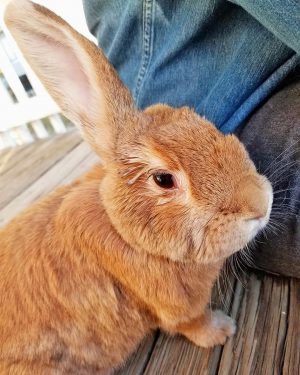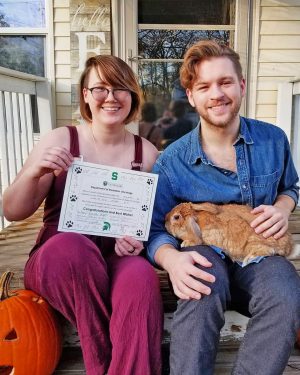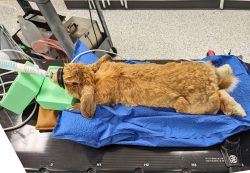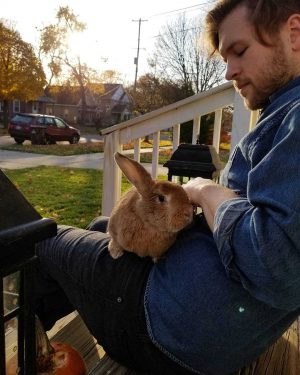
By Katheryn Kutil, Halley Robson, and Kyle LaDuke
Featuring Dr. Leanne Magestro and the MSU Radiation Oncology Service
Meet Nanny, the Unicorn Rabbit
Nanny was a 4-year-old mixed-breed rabbit, most known for her “unicorn” appearance—her owners say that she always held her right ear up and her left ear down. She was rescued from a neglectful owner in 2016 (at 8 months old). Until Nanny was rescued, she had spent the majority of her life in a small cage where she sat in inches of her own waste. “I fell in love with her spunky personality right away,” says Halley Robson, one of Nanny’s owners.
Once at her new home, Nanny’s owner had her spayed and began to bond her with their neutered male rabbit (Butler). “I worked hard to earn Nanny’s trust,” says Kyle LaDuke, Nanny’s owner. “By 2017, the hard work paid off and Nanny was a totally different rabbit. She gained the confidence to give and receive affection.” LaDuke even built her and Butler a 6’x6’ plexiglass enclosure (Nanny was anxious behind cage bars). This rabbit zone was named, “the bun-geon.” Not only did these rabbits have their own lair, but they were taken on nightly trips to the park and given their own kale garden to play in. “We joke with our family, saying that ‘our buns have a better quality of life than we do!’”

In late September of 2020, LaDuke and Robson noticed that Nanny's eyes started to change in appearance; they protruded a bit more usual. That’s when they made her a dental appointment at the Frankenmuth-Birch Run Veterinary Hospital in hopes that would solve the issue. “Domestic rabbits live much longer than wild rabbits—sometimes more than 10 years—and their teeth grow their whole lives—1 cm. a month! So, they need routine dental care,” adds Robson. “Unfortunately, the X-rays revealed a large chest mass, which was causing the increased pressure in her eyes—by restricting venous blood flow from the head to the heart.”
“This was a devastating shock to us,” say LaDuke and Robson. “Nanny was only four and had been really healthy until that point. We spent a few days trying to cope with the news and decide what to do.” At this point, they focused on what they knew: that Nanny was a rabbit, a prey species commonly referred to as shy, timid, and fragile—except Nanny was none of those things. “Nanny was a physical manifestation of pure determination and destruction,” adds LaDuke and Robson. “She could chew her way through anything you put in front of her—cardboard boxes, baby gates, sometimes even the trim of the wall.”
Ultimately, LaDuke and Robson decided to reach out to MSU to explore their options. “She was too strong of a lady for us to not consider treatment options; it wasn’t in her nature to give up, and we wanted to try for her,” they say. “We emailed MSU’s Oncology team on a whim, and Dr. Magestro immediately hit the ground running.”
Some Unicorn Magic (And a Bit About Nanny’s Owners)
Nanny was presented to the MSU Radiation Oncology Service for palliative radiation therapy of a suspect thymoma (cancer of the thymus). At home, LaDuke and Robson noted that she was slightly tachypneic (had excessive, rapid breathing), but her appetite and behavior were still within normal limits.

“Thymomas are generally benign tumors that arise from the thymus, an immune organ that shrinks away as both animals and humans age,” says Leanne Magestro, clinician for the MSU Radiation Oncology Service. “There was a small possibility this tumor could’ve represented a carcinoma that arose from the left lung; this is less likely in rabbits but possible. The only way to attempt to differentiate would be to sample the tissue via a procedure known as a fine needle aspiration. We reviewed the indications for and risks of this test. It would have been critical if Nanny’s owners would have elected full-course treatment for Nanny but would not have changed how palliative care was delivered.”
LaDuke and Robson elected to proceed with palliative radiation therapy for Nanny, and she received four rounds of treatment at MSU. With this cost-effective treatment, Nanny’s veterinary healthcare team was able to reduce and delay the progression of Nanny’s symptoms, having seen a 25–30% decrease in the size of the mass.

“I’m proud to say that I’m a third-year veterinary medical student at the MSU College of Veterinary Medicine!” says Robson. “MSU doesn’t have an exotic animal program. So, I was beyond excited for the opportunity to care for Nanny while working closely with the doctors who love to teach students about the field of medicine that they are passionate about. I also was able to be a part of Nanny’s case as both a caregiver and a family member, an experience that will surely help me to be a more compassionate doctor in the future.”
Prior to Nanny’s passing, LaDuke and Robson reported her to be living her very best bunny life—a life that was extended due to the care of MSU’s Radiation Oncology Service. To honor her extraordinary life, Robson is working with Dr. Magestro on publishing a clinical research paper that identifies the tumor Nanny passed from, a type-A thymoma. This tumor has never before been identified in a rabbit. The hope is to share knowledge with the veterinary community and save other fur friends from the same illness in the future.
Update: Nanny passed away at home during the writing of this story. An autopsy revealed a rare variant of thymoma never before seen in rabbits. While we were hopeful Nanny would live many months at home, she has helped multiple specialists and students at MSU learn in her short time as a patient.
